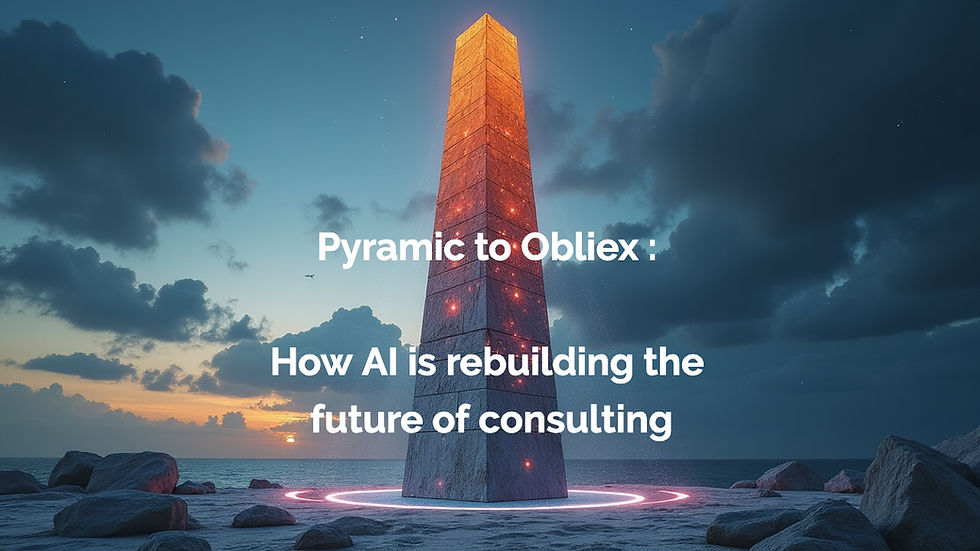How AI Is Rebuilding the Future of Consulting
- Sajal Gupta
- Sep 12, 2025
- 3 min read

AI is not just another tool in a consultant's arsenal—it's the catalyst driving a seismic structural shift across the consulting industry. The debate is no longer whether AI will replace consultants or make them indispensable; it's about the deeper transformation of the very model on which consulting thrives. What stands before the industry today is a stark contrast: the crumbling pyramid and the rise of the consulting obelisk.
The pyramid consulting model is in decline.
For decades, the pyramid model—defined by a broad base of junior consultants delivering research, modelling, and analysis—has powered consulting's economics and identity. This system relied on high-volume billable hours, utilising low-cost junior talent to support the narrow apex of senior partners who shape strategy and client relationships. The margin was created from scale; the culture was built around relentless upward mobility and headcount growth.
But AI has exposed the pyramid's vulnerabilities. Generative and agentic AI have rapidly digitised, automated, and in some cases improved the key tasks once monopolised by junior staff. Tools now scour data, create presentations, and produce sophisticated analyses in minutes. In leading firms, AI assistants like McKinsey's "Lilli" and BCG's "Deckster" are shrinking project cycles, while agent-based platforms at Deloitte and PwC are redesigning workflow at speed and scale. If AI does the work that justifies thousands of junior hours, the base of the pyramid starts to look obsolete.
The Consulting Obelisk: A New Archetype
Enter the consulting obelisk: a tall, narrow, expert-heavy structure that puts AI at the
heart of delivery. In this model, the team is built around three human roles:

AI Facilitators: Early-career experts who design and manage AI-driven workflows.
Engagement Architects: Mid- to senior-level consultants who frame problems, interpret AI findings, and lead strategy design.
Client Leaders: Partners who maintain deep relationships and guide clients through turbulence.
Instead of relying on bulk scale and armies of analysts, the obelisk model delivers sharper insights, greater speed, and lower overhead. By automating foundational work, small, senior teams focus on what AI can't replicate: judgment, creativity, and genuine partnership.
The Enduring Need for Human Expertise
Despite the transformative effects of AI and automation, the fundamental need for consultants is not disappearing. Organisations will continue to seek out external experts for their specialised knowledge, impartial perspective, and ability to synthesise complex challenges into actionable solutions—especially as technology, regulation, and competitive pressures grow more intense. As the business landscape becomes more volatile and the pace of change accelerates, consultants remain invaluable as trusted advisors who can guide clients through strategic transformations, provide clarity amid uncertainty, and deliver tailor-made insights that AI and internal teams alone cannot fully replicate.
Economics: Contrast in Action
Pyramid Model | Obelisk Model | |
|---|---|---|
Team | Broad base, many juniors | Narrow, mostly experts |
Cost | Talent-heavy, high HR costs | Lean, AI-centric, low overhead |
Revenue | Billable hours, leverage | Value-based outcomes, expert fees |
Scaling | HR-limited | Rapid, technology-enabled |
Profit | Markup on labour | Margin from expertise, tech, trust |
Boutique firms like Monevate, SIB, and Unity are already thriving on this model: fast, expert, and lean, with no reliance on the conventional pyramid structure. Their teams are agile pods of senior talent, enabled by powerful proprietary AI, producing outsized impact without high headcount.
The Hurdle of Tradition
Incumbent firms are slow to change, entrenched in legacy compensation, career paths, and billable-hour incentives. While they invest in AI labs and digital skunkworks, the core delivery model too often remains shielded by the inertia of tradition. The hardest shift will be in talent and economic structure: fewer MBAs, less ladder climbing, and more demand for hybrid, AI-fluent thinkers.
What Must Happen Next
Consulting leaders who cling to the pyramid risk irrelevance—they'll be slower, more expensive, and less impactful. Those who embrace the obelisk can deliver more value in less time and at lower cost. They'll also have to set the standard for ethical AI use, embedding transparency and accountability directly into workflows as decision-making gets faster and more technical.
The choice is clear, and the stakes are high. The consulting obelisk is not just cost-cutting—it's a reimagining of where value is created, who delivers it, and how clients measure results. To lead the future, consulting firms must build slim, expert-driven teams, supercharged by AI, that put insight, ingenuity, and trust at the heart of every engagement.



Comments